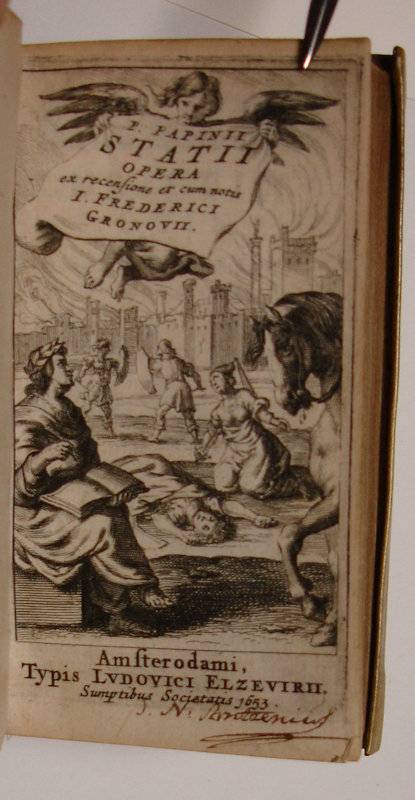STATIUS. P. Papinii Statii Opera ex recensione et cum notis I. Frederici Gronovii.
Amsterdam (Amsterodami)., Typis Ludovici Elzevirii, Sumptibus Societatis, 1653.
16mo. (VIII),424 p. Overlapping vellum 12 cm (
Ref: This edition is 'the most significant stage in the evolution of the printed text of the Thebaid before the late nineteenth century.' (Berlincourt, Classical quarterly, 2016, 66 (1), p. 376-383); Willems 1166; Bergman 2139; Rahir 1189; Copinger 4491; Schweiger 2,965; Dibdin 2,424; Fabricius/Ernesti 2,335; Moss 2,612; Ebert 21682: 'mit grossem Scharfblick und nach guten Hülfsmitteln verbessert') (
Details: Engraved title: a battle scene from the Thebaid, the city of Thebes is in the background, the poet in front) (
Condition: Vellum slightly soiled. Small owner's inscription on the title) (
Note: His fluent and highly polished verse brought the Roman poet Publius Papinius Statius, ca. A.D. 45-96, to the court of the Roman emperor Domitianus. He is best known for his epic, the 'Thebaid', which tells the story of the civil war between the sons of Oedipus, Eteocles and Polynices, contesting power over the city of Thebes. The 'Achilleid', tells the story of the education of Achilles. Statius' 'Silvae' is a collection of 32 occasional poems addressed to his friends, celebrating their marriages etc. In his epic work there are frequent imitations of Vergil in word and thought. (OCD, 2nd e. p. 1011/12)
§ The Thebaid was extraordinary popular during the Middle Ages and the Renaissance. In Dante Statius even ascends to heaven. The 'Thebaid' was used by Boccaccio and Chaucer, and there appeared adaptations in Irish, French and Italian. Also Statius' 'Silvae' enjoyed a vigorous afterlife, and set a standard for the Neolatin poets of the 16th and 17th century. Composing occasional poetry in imitation of Statius was a common pastime among humanist classicists, e.g. Heinsius, Scriverius, Meursius, and in England Milton and Ben Jonson. The works of Statius were ably edited by the Dutch classicist of German origin Johann Friedrich Gronov, or Gronovius, 1611-1671, He was the successor of Heinsius at the University of Leiden, and was influenced by Vossius, Grotius, Heinsius & Scriverius. His editions mark an epoch in the study of Livy, of Seneca, Tacitus & Gellius. His interest to the textual criticism of Latin poetry was due to the discovery of the Florentine MS of the tragedies of Seneca. In his riper years 'the acumen exhibited in his handling of prose is also exemplified in his treatment of the text of poets such as Phaedrus and Martial, Seneca and Statius'. (Sandys, History of Classical Scholarship, 2,321) As an editor and commentator Gronovius played a pivotal role in the history of the works of Statius. This small and light book of 1653 weighs only 120 grams, it is indeed 'pondus non magnum', but especially the notes are 'satis ponderosae', that is, really important. They fill merely 68 pages at the end of this volume, and of these pages the notes to the Thebaid fill only 41, and are concerned with little more than 200 passages. 'Their scope is almost entirely limited to the emendation of the text of Statius'. For the Thebaid Gronovius consulted at least 11 manuscripts. 'The place given to conjecture, though clearly subordinate, is by no means negligible. These notes often involve other aspects as well: Gronovius broad conception of emendation leads him to tackle various questions, whenever they lend support to his views. (...) In his eyes, the dignity of critical studies does not lie in emendation itself, but in the comprehensive knowledge of ancient languages and cultures in which emendation should always be grounded; such knowledge enables the scholar to get the author's genius and thus restore the text from inside'. (V. Berlincourt, 'In pondere non magno satis ponderosae...' Gronovius and the printed tradition of the Thebaid' in: 'The poetry of Statius', Leiden, Boston, Brill, 2008, p. 1-2. (Mnem. Suppl. 306). The Gronovius edition became during the 2 following centuries 'the undisputed foundation of almost every later edition until scholars at last began to base their work on a comprehensive study of the manuscript tradition, that is, until the second Teubner of Otto Müller in 1870'. (Berlincourt, p. 7.) Gronovius' work exercised a great influence over later editors and commentators. 'There is little to find fault with in Gronovius' critical method, as illustrated by his notes, though it is of course still conceived of as being mere emendation of the textus receptus; usually his discussions are well informed, his arguments sound, and his judgement balanced'. (Berlincourt, p. 10)) (
Provenance: On the lower margin of the title we read the name of one 'I.N. Arntzenius', 'J.N. Arnstzenius' or F.N. Arntzenius') (
Collation: *4, A-2C8, 2D4) (Photographs on request)
Book number: 120167 Euro 350.00
Keywords: (Oude Druk), (Rare Books), Achilleid, Achilleis, Altertum, Altertumswissenschaft, Antike, Antiquity, Dichtkunst, Latin literature, Poesie, Silvae, Statius, Sylvae, Thebaid, Thebais, classical philology, poetry, römische Literatur
 STATIUS.
STATIUS.